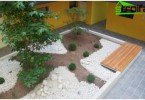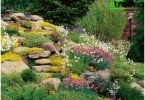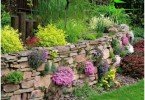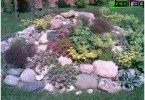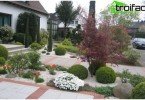Fashion, as you know, does not stand still. It affects all aspects of our lives. And it is not surprising that today, as never before, undersized flowers are popular for flower beds. They have many advantages and, in fairness, increasingly displace highly growing plants. Today they can be seen on almost any flowerbed. Fortunately, the assortment of such colors is quite diverse and includes both annual and perennial species. We will tell you how to create original flower beds and take care of them in the future..
Content
- Secrets of decoration
- Biennial undersized flowers
- Choosing the Right Plants
- Features of flower care
- Do not be afraid of experiments
Secrets of decoration
To design flower beds, you can use the extensive list of perennial low-growing flowers. They can be planted:
- primrose and stonebreaker;
- phlox and felt ascol;
- dwarf astilbe and other perennials.
By rooting them on your site, you can enjoy the fruits of your labor for several years. Moreover, such floral arrangements can be used to decorate borders and flower beds. They also make various edging..
- One of the first plants that revitalizes perennial curtains is primrose. The height of the plant is 20-25 cm. Its raspberry, white, yellow, red and pink flowers in the form of inflorescences can be admired for a long time. If they are watered correctly, then primrose will grow from April to early June.
- May bloom phlox. Their chic large inflorescences are arranged so densely that they completely cover the leaves. When decorating flower beds, awl-shaped phloxes are used, whose height is 10 cm. Douglas phloxes are dwarf in size 5-15 cm. The colorful palette of these delicate plants includes pale pink, purple and (rarely) purple.
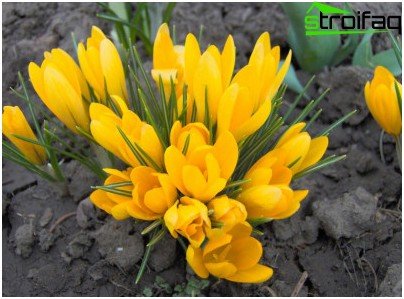
The first spring flowers are particularly bright colors
Biennial undersized flowers
With the approach of autumn, you need to start working with biennial plants. They are sown or planted before the onset of the first cold weather. Why? During the time that snow falls, they must build up the root system and develop a rosette of leaves. When spring comes, their flowering will begin. Such flowers are known to almost everyone. It’s about daisies, pansies, viols and forget-me-nots.
If your flower bed is in the sun or in partial shade, then the viola and pansies will feel good on it. They need to be watered often, although they are considered quite unpretentious in relation to moisture. The viola seedlings planted in February and March will delight their first buds in the summer. At the end of spring, charming hats of daisies appear – white, red, pink (provided that the seeds are planted in the fall). Forget-me-nots need shade and humidity. Subject to these conditions, it will be touching to bloom from early spring to early summer.
Choosing the Right Plants
When you need to green the site in the shortest possible time, you should think about annual low-growing flowers. So you create a colorful pattern immediately in the year of sowing. Many are very fond of floral ornaments. Plants having different colors of not only flowers but also leaves participate in their creation. The most popular crops recognized by many gardeners include:
- evergreen begonia and alissum seaside,
- decorative cabbage and scallop cellosia,
- Houston Ageratum and Seaside Cineraria,
- crested chlorophytum and coleus hybrid,
- varieties of undersized petunias, marigolds and many other plants.
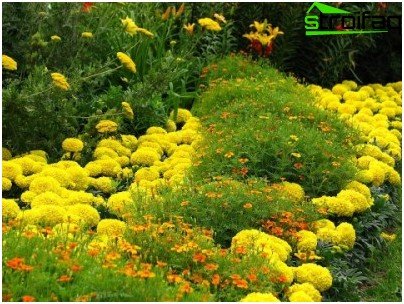
Many of the plants have been familiar to us since childhood.
If your flower bed is located in a sunny place, then it can be supplemented with Houston’s Ageratum – a small plant up to 20 cm high. Its amazing inflorescences form a lush colorful pillow. The plant grows rapidly and closes with itself all the empty spaces in the garden. It does not require increased attention, but only regular watering and plenty of sunlight. If you adhere to this, then white, lilac and blue flowers will delight you, from June to October.
Many people know the common (and no less charming) flowering petunia plant. It can be ampelous and bush. Both types are suitable for the design of flower beds. The bush look can be with large flowers and with many flowers. The latter are planted on the streets, but they are easily damaged by rain, which cannot be said about petunias with large flowers. All plants need attention – compulsory feeding and regular watering.
Features of flower care
Regular care is necessary for any plant. Only then will they have a beautiful and healthy appearance. What include the general rules for caring for the flower bed?
- Loosening the soil;
- regular weeding;
- removal of faded fading inflorescences;
- removal of diseased specimens;
- pest treatment.
Remember that each type of plant has its own characteristics and care.
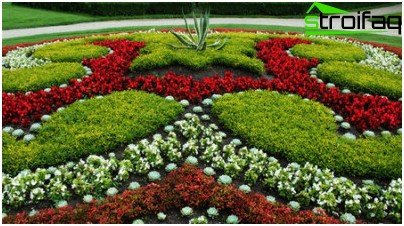
Creating a floral ornament often requires specialist advice.
When caring for stunted flowers, it is important to observe the main condition – to maintain the required height. If the plant is not properly looked after, then it can stretch out due to the strong growth of the shoot. A large mass of green leaves may also build up, which will adversely affect the decorative properties of the flower bed. This usually happens when flowers are heavily fed with nitrogen fertilizers. Therefore, preference should be given to those that stimulate flowering rather than growth. Do not go about the common misconception that you need to feed flowers as much as possible.
Among the reasons why the plant can stretch upwards is a lack of light and too dense planting. This situation arises when an assortment of flowers planted on a shady and penumbra flowerbed is illiterate.
Do not be afraid of experiments
Creativity is a fascinating and often risky process. But without experiments, life would not have progress! Therefore, do not be afraid to fantasize and apply your combinations of plants on a flower bed. One-year crops can be planted next to perennial or two-year crops, as well as perennial crops with two-year crops. For example, on the edges, place annual and biennial species – aster, viola, dwarf tagetes, rejected, simple or terry calendula, begonia. And in the center, place perennial flowers – a tenacious, juvenile, edelweiss, host, stachis, periwinkle, stalk, etc..
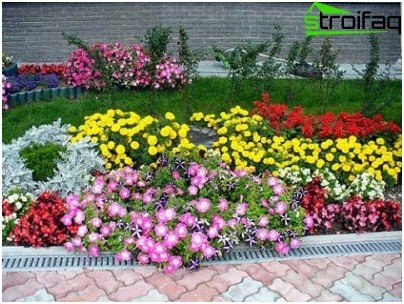
The combination of annual and perennial crops gives an excellent result
A little knowledge, imagination and effort – and a flower bed will be your achievement and pride. You will succeed. Good luck!


